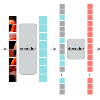The data fusion technology aims to aggregate the characteristics of different data and obtain products with multiple data advantages. To solves the problem of reduced resolution of PolSAR images due to system limitations, we propose a fully polarimetric synthetic aperture radar (PolSAR) images and single-polarization synthetic aperture radar SAR (SinSAR) images fusion network to generate high-resolution PolSAR (HR-PolSAR) images. To take advantage of the polarimetric information of the low-resolution PolSAR (LR-PolSAR) image and the spatial information of the high-resolution single-polarization SAR (HR-SinSAR) image, we propose a fusion framework for joint LR-PolSAR image and HR-SinSAR image and design a cross-attention mechanism to extract features from the joint input data. Besides, based on the physical imaging mechanism, we designed the PolSAR polarimetric loss function for constrained network training. The experimental results confirm the superiority of fusion network over traditional algorithms. The average PSNR is increased by more than 3.6db, and the average MAE is reduced to less than 0.07. Experiments on polarimetric decomposition and polarimetric signature show that it maintains polarimetric information well.
翻译:为了解决由于系统限制而降低PolSAR图像分辨率的问题,我们提议建立一个全极合成孔径雷达(PolSAR)图像和单极合成孔径雷达(Sinsar)图像聚合网络,以生成高分辨率PolSAR(HR-PolSAR)图像。为了利用低分辨率PolSAR(LR-PolSAR)图像的对数信息以及高分辨率单极化合成孔径雷达(HR-SinSAR)图像的空间信息,我们提议建立一个用于联合LR-PolSAR图像和HR-SinSAR图像的全极合成孔径合成孔径雷达(SinsAR)图像和单一极地合成孔径雷达(SinsAR)图像聚合网络,并设计一个从联合输入数据中提取特征的跨度注意机制。此外,我们根据物理成像机制设计了PolSAR极地测量损失功能,以进行限制网络培训。实验结果证实聚变网络优于传统算法。平均PSNRRR的增幅超过3.6db,平均MAE图像降为低于0.07,并维持了对极地观测的实验性数据。





